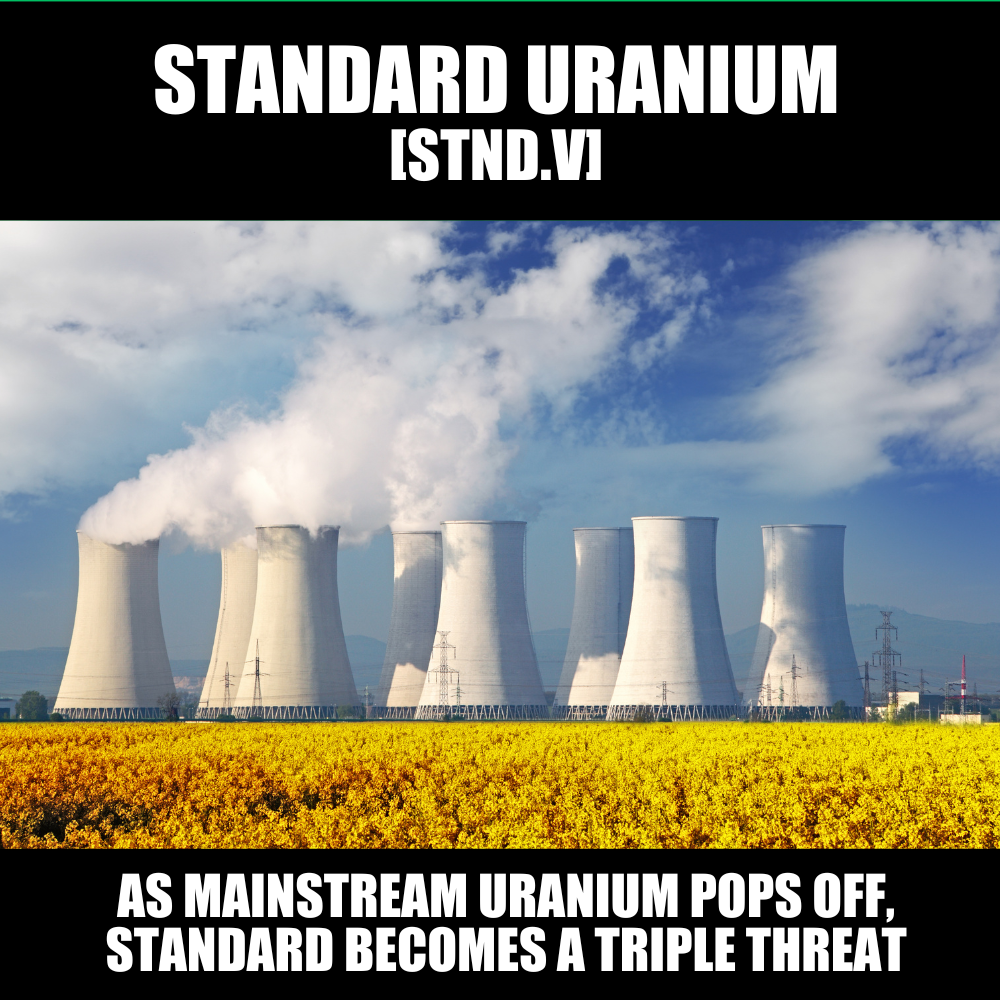 Disclaimer: This article has been paid for by Standard Uranium. See disclosures at the bottom of the page.
Disclaimer: This article has been paid for by Standard Uranium. See disclosures at the bottom of the page.
Standard Uranium (TSX-V: STND) has gone from basement-tier micro-cap to a uranium stock worth watching in a short amount of time, and its timing couldn’t be better.
STND went hog wild on the back of news the crew was zeroing in on the Davidson River project this season but, despite that leap, the company is not a single drill target deal—it’s a multi-pronged explorer with tech-driven precision at Davidson River, radioactivity validation at Sun Dog, and now high-grade blue-sky upside at Corvo. And all this is happening against a backdrop of roaring uranium prices and institutional capital flooding the space.
The Big Dogs are Barking
Sprott recently announced a massive US $200 million commitment to purchase physical uranium for a dedicated fund—more than doubling their original allocation within hours—highlighting intense investor appetite in a market where supply lags demand by 50–60 million pounds annually and term prices sit near US $80/lb. This comes hot on the heels of a C$100 million bought deal for their Physical Uranium Trust, reflecting the bullish momentum in the nuclear space as utilities, governments, and institutional players race to secure inventory amid tightening supply chains.
So Who is Standard and Why do They Matter?
Standard Uranium has quietly built a portfolio across the Athabasca Basin over the last few years—Davidson River being the flagship, but with several other satellite plays in their bag. For years it flew under the radar – that all began to shift late May when our feature story at Equity.Guru spotlighted a shift in focus.
The result? A 90% surge in three days—not on flashy drill results, but because STND finally looked like a real explorer: serious tech, smart proven crew behind it, and a shot at real hits.
Davidson River: Technology Sparks the Run
The driving catalyst for that spike was the ExoSphere passive seismic survey—run in partnership with Fleet Space—mapping basement conductors in real-time and zeroing in on drill-ready targets. That kind of modern imaging isn’t gimmickry; it’s the kind of tool that can save drilling dollars and define targets long overlooked. The market recognized it.
Sunshine at Sun Dog
Then came Sun Dog’s Hobbes target update—radioactivity readings soared over 19,000 cps within a broader alteration zone. That kind of scintillometer reading is the classic Athabasca siren call: basement structures, faulting, alteration—basically everything you want to see before drilling.
Corvo: Double the Catalysts
Corvo changed the conversation again. With a 100% earn-in agreement signed this year, Standard is aggressively advancing this project through July mapping, Q4 gravity surveys, and targeted Q1 2026 drilling.
More importantly, historic surface samples at Corvo blew out grades up to 6% U₃O₈—deposit-grade headline numbers that grab attention. That gives STND two live stories with timing, milestones, and serious optionality.
Macro: Uranium Momentum & Capital Waves
The macro environment for uranium couldn’t be more favorable. Uranium pricing remains tight, supported by decarbonization-driven nuclear demand, global supply constraints, and geopolitical tailwinds from Western energy policy pulls.
Spot uranium recently hovered near US $70–80/lb—down a touch from peak but still well above long-term averages.
And then there’s Sprott. That’s not fringe money: that’s mainstream “nuclear as infrastructure” capital piling in.
New nuclear initiatives are popping up everywhere and serious explorers looking to open up new areas and progress quickly are rare.
The Takeaway
STND isn’t a one-note junior any more—it’s a double-trigger story in a uranium bull market that’s energized by policy support and whale buyers. You’ve got:
-
Davidson River—tech-driven targeting and drills ahead.
-
Sun Dog—radioactive basement confirmation giving credibility.
-
Corvo—blue-sky, ultra-high grades and a defined program roadmap.
All in a rising uranium price environment, backed by big capital moves like Sprott’s fundraising. That combo puts STND in a sweet spot—defensible story AND headline leverage, not just speculative “maybe someday.”
What to Watch
-
Interpretation from Davidson River seismic—when do they turn to drill?
-
Assay results from Sun Dog—confirmation turns hype into hard data.
-
Corvo fieldwork ahead of Q1 2026 drill—surface samples and gravity trends matter.
-
Wider uranium story—spot price, Sprott inflows, and policy headlines.
Between now and early 2026, STND has multiple catalysts lined up. If even one kicks off, it could rerate the name and change the game.
— Chris Parry
FULL DISCLOSURE: Equity.Guru/Parry Research has an agreement with Standard Uranium and may purchase stock in the company. EG/PR does not make buy/sell recommendations but you should consider any coverage in which we show the Equity.Guru client company badge as being potentially conflicted, and any investment you make in a public company as having inherent risk. This content was approved by the company before publishing.
ISSUER-PAID ADVERTISEMENT. STANDARD URANIUM., or the “Company,” has or will pay Equity.Guru/Parry Resarch (“Publisher”) in cash $15,000 for marketing services, including advertisements. This advertisement is part of those issuer-paid marketing services. This compensation should be viewed as a major conflict with Publisher’s ability to be unbiased.
FORWARD LOOKING STATEMENTS. This publication contains forward-looking statements, including statements regarding expected continual growth of the featured company and/or industry. The Publisher notes that statements contained herein that look forward in time, which include everything other than historical information, involve risks and uncertainties that may affect the companies’ actual results of operations. Factors that could cause actual results to differ include, but are not limited to, government regulations concerning uranium production, the size and growth of the market for uranium, the companies’ ability to fund its capital requirements in the near term and long term, pricing pressures, etc.


Leave a Reply